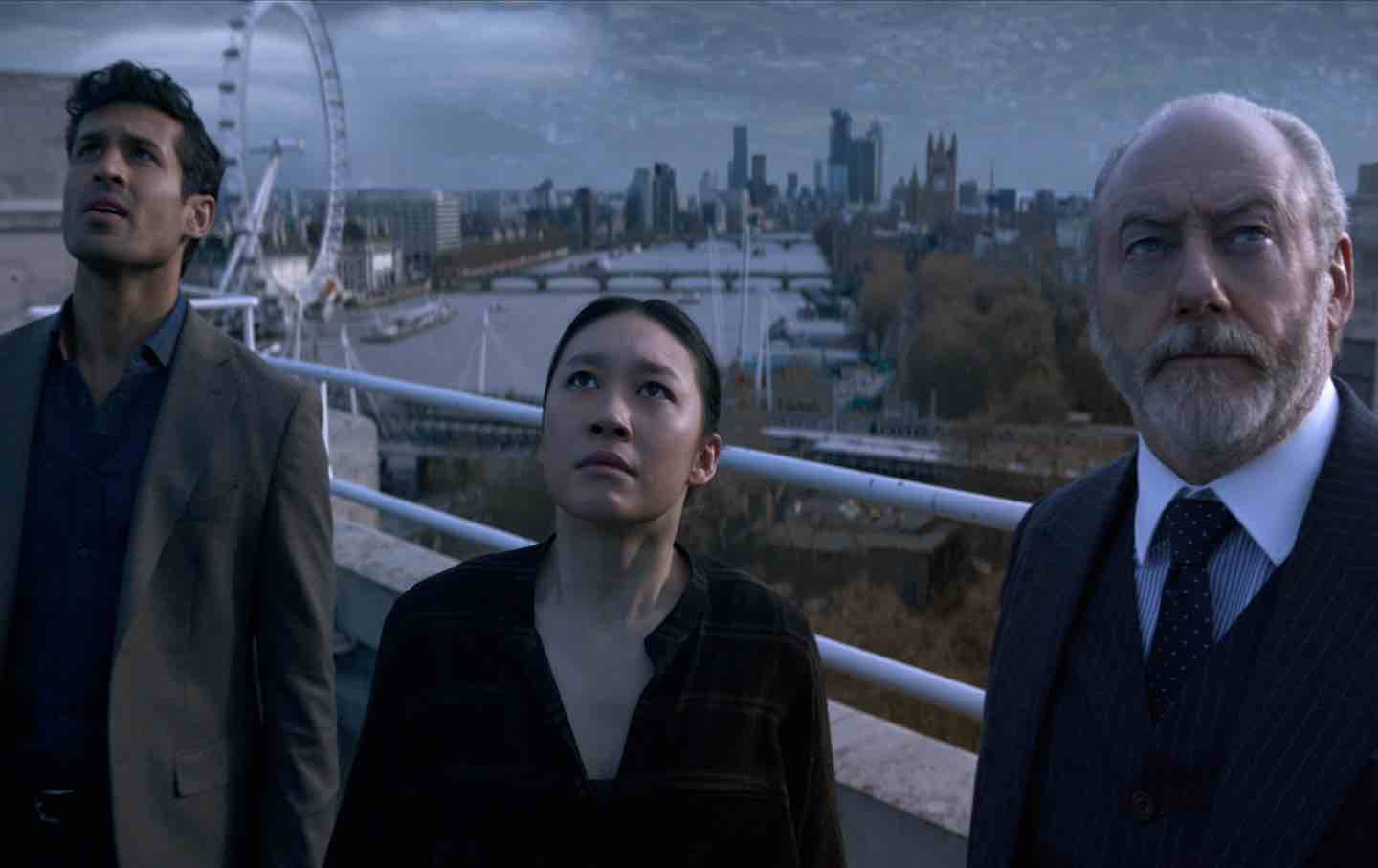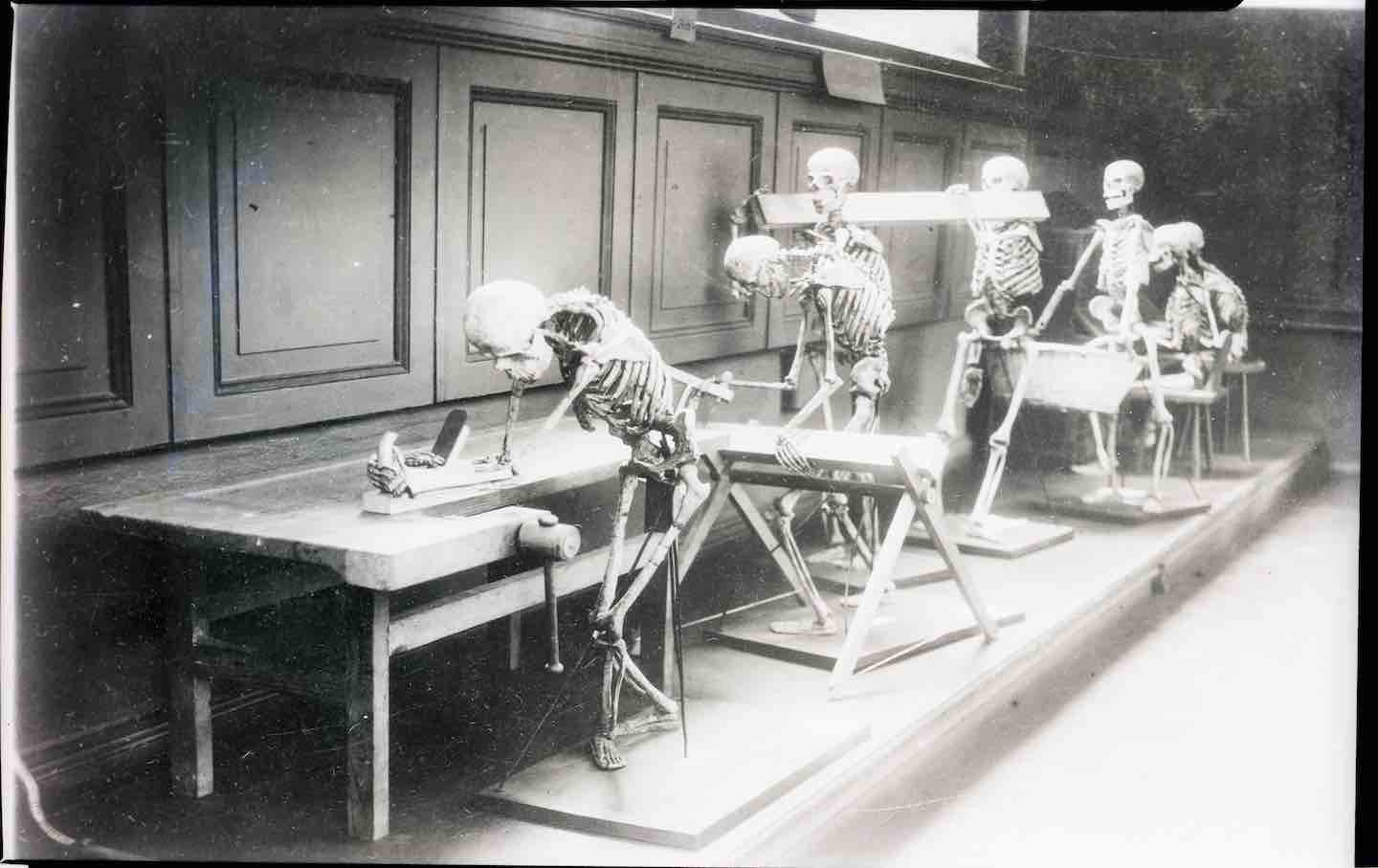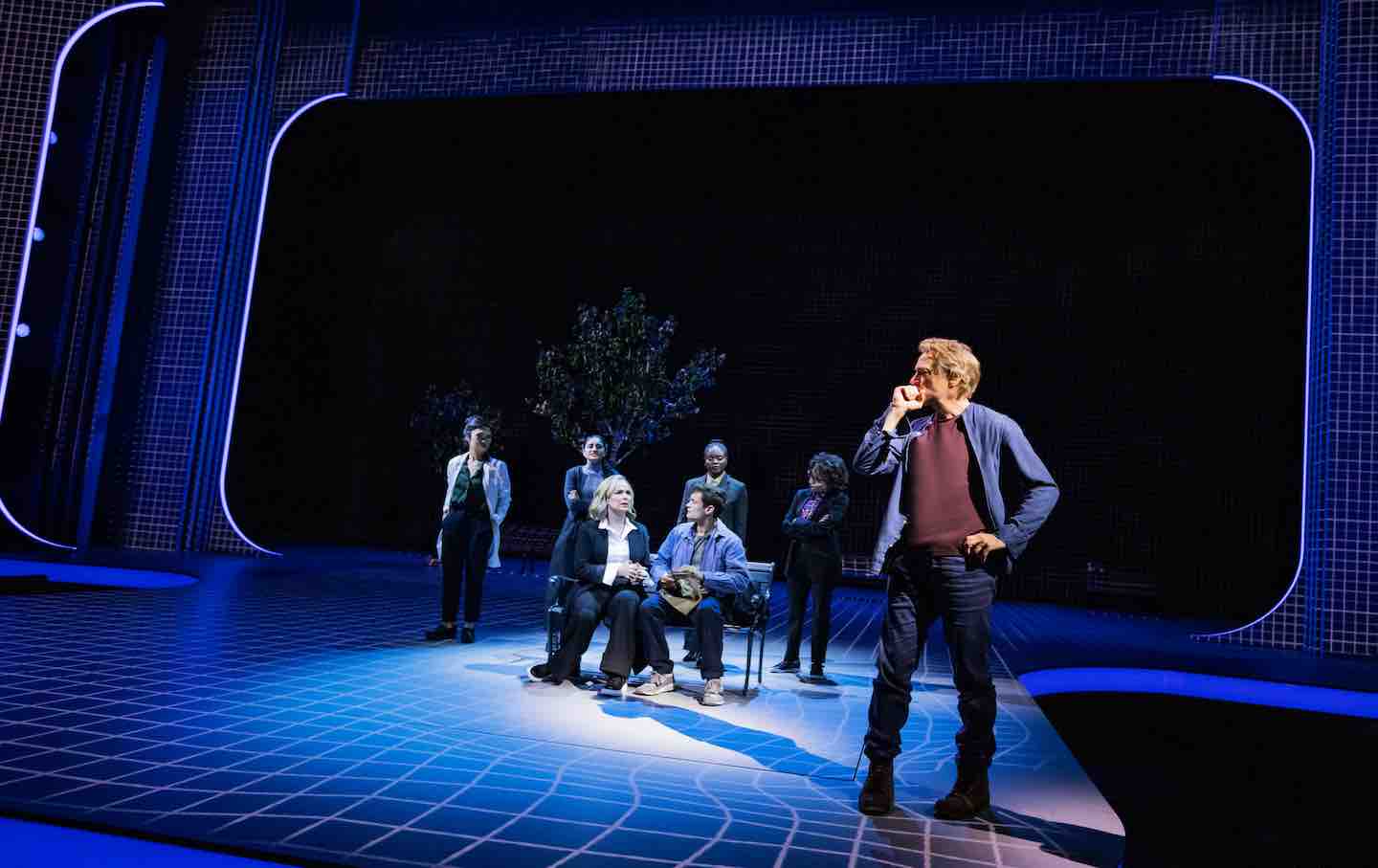What’s Ailing Prestige TV?
In Netflix’s big budget series 3 Body Problem, the flaws of this era of streaming is laid bare.

Saamer Usmani as Raj Varma, Jess Hong as Jin Cheng, Liam Cunningham as Wade in 3 Body Problem.
(Courtesy of Netflix)In the fifth episode of 3 Body Problem, the awkwardly titled Netflix adaptation of Liu Cixin’s best-selling sci-fi novel, a strange act of violence takes place. The United Kingdom’s Royal Navy, in conjunction with a shadowy intelligence agency, deploys advanced nanofiber technology, created by idealistic scientist Auggie Salazar (Eiza González), to ambush a secret organization’s rogue ship. They use the nanofibers to create lengthy, all-but-invisible piano wire that essentially juliennes the ship, slicing it and everybody on board in half, all to acquire a small hard drive of data.
The set piece aspires to be a disturbing visual feat—men, women, and children horrifyingly disposed of by sinister government forces in the name of the greater good—but its intended effect never quite lands: Rather than inspire horror, it seemed more mundane. The people on the ship, with the sole exception of the organization’s elderly leader, Mike Evans (Jonathan Pryce), are entirely anonymous, robbing their deaths of dramatic potency beyond the images of people running for their lives. The episode’s director, Minkie Spiro, said that she tried to create much of the destruction using practical effects, but the heavy reliance on post-production visual effects lends a chintzy, unreal quality to the sequence. Watching someone collapse into a pool of their blood and flesh should plainly be upsetting, but in 3 Body Problem, the added solemnity and contrived dramatic tension make it feel weightless.
However, much like the series as a whole, the idea behind the sequence isn’t without merit: Is scientific progress valuable even though it’s used to spread mass death? Auggie’s nanofiber technology was intended for life-saving purposes, but it becomes a weapon in wartime. Series showrunners David Benioff, D.B. Weiss, and Alexander Woo do their best to emphasize various similar questions underpinning their interpretation of Liu’s work, which broadly chronicles humanity’s fight against an alien race fleeing its planet to conquer Earth. What do we owe to a world that we might never live to see? Who decides our future and how to preserve it? Do we deserve to be destroyed?
I have not read Liu’s novels, nor seen the Chinese adaptation of The Three-Body Problem, but it’s my understanding that his work creates a faithful, and critical, facsimile of Chinese bureaucratic and political structures in which realpolitik trumps sentimental notions of morality. In the context of fighting off an alien invasion, Liu’s vision of politics, then, can seem defined by an emphasis on cold, scrupulous strategies that ultimately view individual human beings as expendable in the struggle for planetary survival. By Liu’s own admission, his Remembrance of Earth’s Past trilogy, of which The Three-Body Problem is the first in the series, is more concerned with speculative concepts than with emotional legibility, reducing the characters to types and focusing on story above all else. (“I did not begin writing for love of literature,” he told The New Yorker. “I did so for love of science.”)
It might have been interesting to see an American adaptation of Liu’s work that embraced a calculating tone and privileged imagination over character, possibly with actors who adopt a Bressonian approach that eschews interiority. Unfortunately, the Netflix version of the book, to my eyes, combines a hardheaded, bird’s-eye view of humanity with a saccharine approach to individuals. Adapting a book steeped in Chinese culture for Anglo-American audiences inevitably means molding elements of the source material to different norms, and 3 Body Problem takes many liberties in this regard, and yet it still embraces the worst impulses of contemporary storytelling. This strange amalgamation of source material and prestige TV plotting ensures that the show’s inherently high stakes—the fate of the world—are undercut by its execution, one defined by narrative half measures and visual shortcuts. One wonders what’s the point of spending $20 million per episode if you’re short-selling the intellect and intrigue of your source material.
The shadow of Mao’s Cultural Revolution weighs heavily over Liu’s novel and by extension, though to a lesser degree, the Netflix series. When the Cultural Revolution broke out, Liu’s father lost his job and was sent to work in a coal mine; Liu, then all of 4 years old, was sent to live with his grandparents for years. Both the novel and the Netflix series open with the death of a physics professor during a struggle session, a violent public spectacle organized by the Red Guards in which “class enemies” were publicly humiliated and attacked to instill mass ideological reform. The professor is killed for refusing to denounce Einstein’s theory of relativity, which was considered “bourgeois science” and counterrevolutionary at the time.
It’s this lynching, cheered on by a rabid crowd, that instills nihilism in the professor’s daughter, Ye Wenjie, played by Zine Tseng. Branded as a traitor and forced to work in a logging camp, Ye is introduced to man-made environmental destruction before being imprisoned for having contraband literature—Rachel Carson’s anti-pesticide conservationist treatise Silent Spring. Eventually, government officials transfer her to a remote mountain site, where they utilize her scientific aptitude—she was an astrophysicist before being sent to the camp—for a secret project revealed to be the search for extraterrestrial life. When Ye amplifies the hub’s weak radio signal by bouncing it off the sun, she receives a message from an alien life-form bearing a warning: “If you respond, we will come. Your world will be conquered. Do not answer.” She disregards the threat and replies, with a palpable resentment toward the rest of her species: “Come. We cannot save ourselves. I will help you conquer this world.”
At the very least, the scenes in mid-1960s China provide a convincing enough portrait of the oppression that would drive someone to turn against the human race. (Zine’s defiant scowl does a lot of heavy lifting.) Still, 3 Body Problem is too comfortable allowing these scenes to have a retrospective effect. On their own, they’re only intermittently effective. While the struggle-session sequence has a visceral quality that overwhelms the deficiencies in writing and direction, Ye’s later experiences in the camp and prison are barely sketched out, despite the historical context. The obvious, universal takeaway is that people are capable of monstrous cruelty, and yet the specificity of the Cultural Revolution as a radicalizing origin gets lost as the series evolves. Rather than a consequential historical event, it becomes, like so many things in 3 Body Problem, nothing more than window dressing. A once-compelling hook gets lost in the shuffle as soon as the series expands beyond its immediate need.
As 3 Body Problem shifts to contemporary London, it becomes an ensemble portrait. A group of Oxford PhD candidates gather for the funeral of their professor, Ye’s daughter, after she abruptly commits suicide—one of many scientists who have mysteriously taken their own lives for unknown reasons. The “Oxford Five,” inspired by and expanded from various characters littered throughout Liu’s series, are sketchily introduced and characterized. Ironically and unintentionally, the cast falls in line with Liu’s vision of his characters as types first and individuals second. Their stilted performances and the series’ contrived writing reduce them to broad categories like the lovelorn nice guy and the crude comic relief. Yet some transcend their archetypes and become memorable by plot necessity (or the sheer accretion of time), like Jin Cheng (Jess Hong) and Saul Durand (Jovan Adepo), both of whom play crucial roles in the global effort to protect Earth, albeit the latter only at the very end of the season. Others, like Will Downing (Alex Sharp) or Jack Rooney (John Bradley), struggle to move beyond their tragic functions (dying of cancer and being murdered by an alien, respectively).
Some of the issues that plague 3 Body Problem are symptomatic of streaming television in general. Eight episodes, of varying lengths, that are studiously on task with larger narrative demands hardly offer enough time to generate investment in a complex story that spans geography and time; thus, many moments feel either rushed or needlessly labored over. It’s difficult to build suspense when the characters, and their general function in the story, feel permanently vague, especially when they’re played by actors who are unable to pick up the slack. Watching 3 Body Problem can sometimes feel like an illustration of how contemporary serialized storytelling has become grievously inert.
Liu’s imaginative ideas should theoretically be compelling on their own merits, but their visual rendering leaves a lot to be desired, too. A major element of the first half of 3 Body Problem involves a strange VR headset that thrusts its users into an immersive video game that essentially teaches them why the San-Ti, an alien species, are heading to conquer Earth. It uses world-historical settings as a pedagogical tool to explain the cosmic, and climactic, strife on their home planet, which has a three-sun solar system that cleaves their civilization into stable and chaotic eras. While life can thrive during the stable eras, the chaotic eras feature dangerous, unpredictable weather patterns that render the planet uninhabitable. The players essentially witness the discontinuous evolution of the San-Ti civilization while trying to solve the unsolvable three-body problem that dictates life on their planet.
In the series, Jin and Jack become obsessed with the game, partly because it plays upon their hard-science skill sets (and nerd bona fides), but also because it’s apparently so realistic and captivating that you feel like you’re actually in Shang Dynasty China or Tudor England. Yet whether it’s because of Netflix’s video compression format or the series’ visual effects work, the game sequences look tacky and cheap. The expansive landscapes have the patina of screensavers and hardly inspire awe.
Popular
“swipe left below to view more authors”Swipe →The series fares better with visually rendering the Sophons, small supercomputers deployed by the San-Ti to monitor and influence human beings, which occasionally take the goofy but effectively simple form of a katana-wielding female avatar. Since the San-Ti anticipate that human beings will technologically surpass them in the 400 years it will take to reach Earth, they plan to cripple scientific progress along the way by sowing social chaos. Initially, they use the Sophons to manipulate scientists into suicide. Later, when they announce their presence to the world, though still en route and centuries away, they project messages onto every electronic screen around the globe that read “YOU ARE BUGS!” as a large floating eye envelops the sky.
The San-Ti have a vested interest in instilling despair across Earth, but 3 Body Problem only occasionally hints at how futility trickles down into the larger social fabric, such as an evocative image of bodies hanging from lampposts as a response to a doomed future. In the sixth episode, the world responds with mass panic to the possibility of the human race being destroyed in a few centuries, which is slightly ironic considering that the real-world catastrophic analogue—the specter of climate change—inspires indifference in so many of us. The shock and violence of an extraterrestrial takeover might arguably stir up more active feelings, but the delayed timeline engenders a similar dilemma: If we won’t live to see such horrors, why should we live our lives any differently? Although 3 Body Problem focuses mainly on the emerging global resistance to the San-Ti, it barely grazes the surface of how a bleak outlook impacts the psychology of people whom the movement is desperately trying to save.
Minor hay has been made about the mixed reception that 3 Body Problem has received in China. Some viewers there, who have used VPNs and piracy to watch the Netflix series despite a nationwide ban, have described it as “General Tso’s chicken” compared to the 2023 Chinese adaptation, criticizing the various changes in the characters’ race and gender as well as the “dumbing down” of the science. These adaptation choices are in the service of lending an international flavor to the series, and while certain casting decisions might be clumsy, they’re hardly the reason the series suffers. (In fact, 3 Body Problem generally improves when it embraces genre impulses, like action-movie violence or gory spectacle.)
The problem lies more with the combination of what The New Yorker’s Jiayang Fan describes as Liu’s “systems-level view of human societies” and the American style of psychological storytelling. The Netflix series filters the various quandaries in the fight for humanity’s survival through relatively small-scale emotional conflicts. Suffering from late-stage pancreatic cancer, Will expresses his lifelong unrequited love for Jin by agreeing to have his brain extracted and sent into space to intercept the San-Ti ahead of time. Auggie, horrified by how the world government has turned her nanofibers into a weapon, rejects the war effort to help developing nations with her tech. Saul is shaken out of his apathy to the San-Ti threat when his one-night stand is accidentally killed during an assassination attempt meant for him.
The result is a confused mishmash: The rational, scientific side of the story isn’t coldly detailed enough to captivate, and its emotional side feels too superficial or muddled to cut deep. Neither humanity nor the individuals in charge of its viability sport much dimensionality. What remains are the ideas transferred from the source material that aren’t supported visually or narratively. Clarence (Benedict Wong)—a dedicated, no-nonsense British investigator who is also the show’s best character on account of Wong’s performance—closes the season with a plainly moving speech about the resilience of bugs in the face of myriad attempts to eradicate them from the planet, illustrating that people carry that same capacity as well. 3 Body Problem spends a whole season failing to illustrate that very concept, preferring instead to state it as fact in the vague hope that we’ll continue watching.
We cannot back down
We now confront a second Trump presidency.
There’s not a moment to lose. We must harness our fears, our grief, and yes, our anger, to resist the dangerous policies Donald Trump will unleash on our country. We rededicate ourselves to our role as journalists and writers of principle and conscience.
Today, we also steel ourselves for the fight ahead. It will demand a fearless spirit, an informed mind, wise analysis, and humane resistance. We face the enactment of Project 2025, a far-right supreme court, political authoritarianism, increasing inequality and record homelessness, a looming climate crisis, and conflicts abroad. The Nation will expose and propose, nurture investigative reporting, and stand together as a community to keep hope and possibility alive. The Nation’s work will continue—as it has in good and not-so-good times—to develop alternative ideas and visions, to deepen our mission of truth-telling and deep reporting, and to further solidarity in a nation divided.
Armed with a remarkable 160 years of bold, independent journalism, our mandate today remains the same as when abolitionists first founded The Nation—to uphold the principles of democracy and freedom, serve as a beacon through the darkest days of resistance, and to envision and struggle for a brighter future.
The day is dark, the forces arrayed are tenacious, but as the late Nation editorial board member Toni Morrison wrote “No! This is precisely the time when artists go to work. There is no time for despair, no place for self-pity, no need for silence, no room for fear. We speak, we write, we do language. That is how civilizations heal.”
I urge you to stand with The Nation and donate today.
Onwards,
Katrina vanden Heuvel
Editorial Director and Publisher, The Nation
More from The Nation

The Perils of a Post-Racial Utopia The Perils of a Post-Racial Utopia
In Nicola Yoon’s One of Our Kind, a dystopian novel of a Black upper-class suburb’s secrets, she examines the dangers of choosing exceptionalism over equality.

Why Americans Are Obsessed With Poor Posture Why Americans Are Obsessed With Poor Posture
A recent history of the 20th-century movement to fix slouching questions the moral and political dimensions of addressing bad backs over wider public health concerns.

Thomas Müntzer’s Misunderstood Revolution Thomas Müntzer’s Misunderstood Revolution
A recent biography of the German preacher and leader of the Peasants’s War examines what remains radical about the short-lived rebellion he led.

Is It Possible to Suspend Disbelief at Ayad Akhtar’s AI Play? Is It Possible to Suspend Disbelief at Ayad Akhtar’s AI Play?
The Robert Downey Jr.–starring McNeal, which was possibly cowritten with the help of AI, is a showcase for the new technology’s mediocrity.

Possibility, Force, and BDSM: A Conversation With Chris Kraus and Anna Poletti Possibility, Force, and BDSM: A Conversation With Chris Kraus and Anna Poletti
The two writers discuss the challenges of writing about sex, loneliness, and the new ways novels can tackle BDSM.

Lore Segal’s Stubborn Optimism Lore Segal’s Stubborn Optimism
In her life and work, she moved through the world with a disarming blend of youthful curiosity and daring intelligence.


